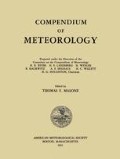Abstract
It has long been recognised that clouds of ice particles have a characteristically fibrous appearance very different from that of droplet clouds, which look “solid” and have more sharply defined edges, even when dissipating. Small, isolated trails of snow or soft hail, known as Fallstreifen (fall-streaks) or virga, which fall from medium-level clouds, also possess this fibrous structure, and when they become separated from their parent clouds and are seen in a favourable light exactly resemble forms of true cirrus. A fibrous structure on a coarser scale can also be seen in rain beneath shower clouds.
Access this chapter
Tax calculation will be finalised at checkout
Purchases are for personal use only
Preview
Unable to display preview. Download preview PDF.
References
Aanensen, C. J. M., “Unusual Condensation Trails.” Meteor. Mag., 77: 17–18 (1948).
Austin, J. M., “A Note on Cumulus Growth in a Non-saturated Environment.” J. Meteor. 5: 103–107 (1948).
Byers, H. R., and Braham, R. R., Jr., “Thunderstorm Structure and Circulation.” J. Meteor. 5: 71–86 (1948).
Cwilong, B. M., “Observations on the Incidence of Supercooled Water in Expansion Chambers and on Cooled Solid Surfaces.” J. Glaciol., 1: 53–57 (1947).
Findeisen, W., “Die kolloidmeteorologischen Vorgänge bei der Niederschlagsbildung.” Meteor. Z., 55: 121–133 (1938).
Findeisen, W., “Über die Entstehung der Gewitterelektrizität.” Meteor. Z., 57: 201–215 (1940).
Findeisen, W. und Findeisen, E., “Untersuchungen über die Eis-splitterbildung an Reifschichten.” Meteor. Z., 60: 145–154 (1943).
Findeisen, W., und Schulz, G., “Experimentelle Unter suchungen über die atmosphärische Eisteilchenbildung, I.” Forsch. Erfahr Ber. Reichs. Wetterd., Reihe A, Nr. 27, Berlin (1944).
Fournier d’Albe, E. M., “Some Experiments on the Condensation of Water Vapour at Temperatures Below 0°C.” Quart. J. R. meteor. Soc., 75: 1–14 (1949).
Krastanow, L., “Über die Bildung der unterkühlten Wassertropfen und der Eiskristalle in der freien Atmosphare.” Meteor. Z., 57: 357–371 (1940).
Krastanow, L., “Beitrag zur Theorie der Tropfen- und Kristallbildung in der Atmosphäre.” Meteor Z., 58: 37–45 (1941).
Ludlam, F. H., “The Forms of Ice-Clouds.” Quart. J. R. meteor. Soc., 74: 39–56 (1948).
Meteorological Office, Air Ministry, London, “Air-frame Icing at Low Temperature.” Mem. meteor. Off., Lond., 494 (1946).
Palmer, H. P., “Natural Ice-Particle Nuclei.” Quart. J. R. meteor. Soc., 75: 15–22 (1949).
Rau, W., “Gefriervorgänge des Wassers bei tiefen Temperaturen.” Schr. dtsch. Akad. Luftfahrtforsch., 8: 65–84 (1944).
Regener, E., “Versuche iiber die Kondensation und Sublimation des Wasserdampfes bei tiefen Temperaturen.” Schr. dtsch. Akad. Luftfahrtforsch., 37: 15–24 (1941).
Schulz, G., “Die Arbeiten und Forschungsergebnisse der Wolkenforschungsstelle des Reichsamtes für Wetterdienst in Prag.” Ber. dtsch. Wetterd., U. S.-Zone, Nr. 1, SS. 3–12 (1947).
Schumacher, C., “Beobachtungen an einer Altokumulusdecke.” Z. angew. Meteor., 57: 214–220 (1940).
Schwerdtfeger, W., “Über die hohen Wolken.” Wiss. Abh. D. R. Reich. Wetterd. Bd. 5, Nr. 1, 34 SS., Berlin (1938–39).
Wall, E., “Die Eiskeimbildungin Lösungskernen.” Meteor. Z., 60: 94–104 (1943).
Wegener, A., Thermodynamik der Atmosphäre. Leipzig, J. A. Barth, 1911.
Weickmann, H., “Experimentelle Untersuchungen zur Bildung von Eis und Wasser an Keimen bei tiefen Temperaturen.” Zent. wiss. Ber. Luftfahrtforsch., Forsch. Ber. Nr. 1730, Berlin-Adlershof (1942).
Weickmann, H., “Formen und Bildung atmosphärische Eiskristalle.” Beitr. Phys. frei. Atmos., 28: 12–52 (1945).
Weickmann, H., “Die Eisphase in der Atmosphäre.” Ber. dtsch. Wetterd., U. S.-Zone Nr. 6, 54 SS. (1949). (Wölkenrode Report and Translation No. 716, Feb. 1947, Library Translation No. 273. Ministry of Supply, Sept. 1948.)
Author information
Authors and Affiliations
Editor information
Rights and permissions
Copyright information
© 1951 American Meteorological Society
About this chapter
Cite this chapter
Ludlam, F.H. (1951). The Physics of Ice Clouds and Mixed Clouds. In: Malone, T.F. (eds) Compendium of Meteorology. American Meteorological Society, Boston, MA. https://doi.org/10.1007/978-1-940033-70-9_16
Download citation
DOI: https://doi.org/10.1007/978-1-940033-70-9_16
Publisher Name: American Meteorological Society, Boston, MA
Online ISBN: 978-1-940033-70-9
eBook Packages: Springer Book Archive

